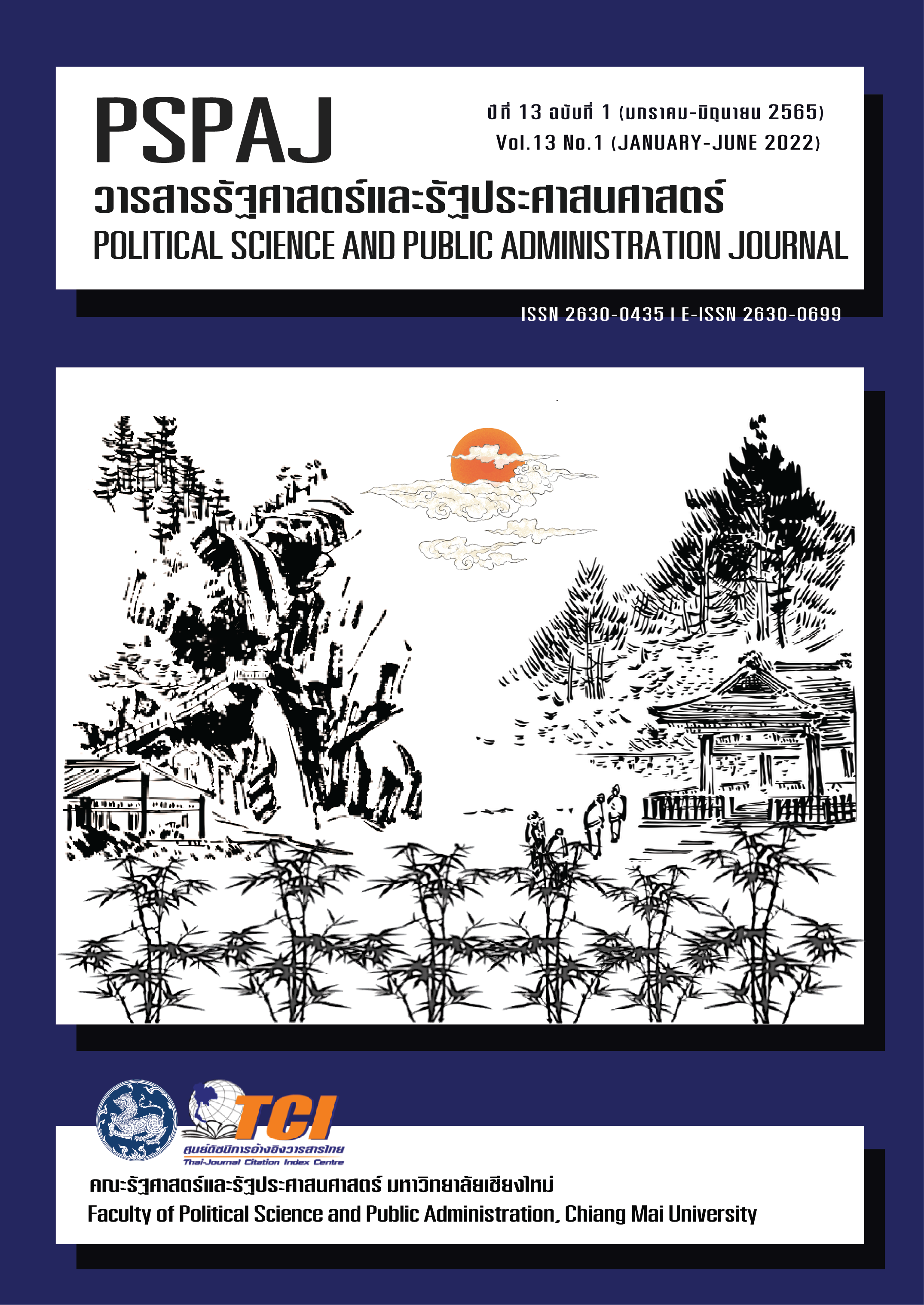ตัวแบบการพัฒนานโยบายการจัดการท่าเรือน้ำลึกเพื่อการสร้างความยั่งยืนแก่สิ่งแวดล้อมทางทะเลและชายฝั่ง กรณีศึกษาท่าเรือน้ำลึกแหลมฉบัง จังหวัดชลบุรี
Main Article Content
บทคัดย่อ
การวิจัยนี้มีวัตถุประสงค์เพื่อศึกษาสถานภาพ แนวทาง และนำเสนอตัวแบบการพัฒนานโยบายการจัดการท่าเรือน้ำลึกแหลมฉบัง เพื่อการสร้างความยั่งยืนแก่สิ่งแวดล้อมทางทะเลและชายฝั่ง โดยใช้ระเบียบวิธีวิจัยเชิงคุณภาพ ซึ่งมีแบบสัมภาษณ์เจาะลึกรายบุคคลเป็นเครื่องมือเก็บข้อมูล จากกลุ่มเป้าหมายที่มาจากผู้มีบทบาทเกี่ยวข้องกับท่าเรือแหลมฉบังโดยตรง และโดยอ้อม จำนวน 21 ราย และใช้เทคนิคการวิเคราะห์เนื้อหาเป็นเครื่องมือวิเคราะห์ข้อมูลผลการศึกษาพบว่า 1) ปัจจุบันท่าเรือน้ำลึกแหลมฉบังยังไม่มีนโยบายเฉพาะด้านการจัดการสิ่งแวดล้อมทางทะเลและชายฝั่ง แต่มีการดำเนินการในลักษณะกิจกรรมภายใต้นโยบายภาพรวมของการท่าเรือแห่งประเทศไทย โดยประสบปัญหาด้านการขาดเอกภาพ การบูรณาการ หน่วยงานรับผิดชอบเฉพาะด้าน และขาดการมีส่วนร่วมของชุมชนและองค์กรปกครองส่วนท้องถิ่นเท่าที่ควร 2) แนวทางการพัฒนานโยบายในอนาคต ควรมีนโยบายเฉพาะด้านการจัดการสิ่งแวดล้อมทางทะเลและชายฝั่ง โดยเชื่อมโยงกับกติกาสากล นโยบายของภาครัฐ และบริบทพื้นที่ รวมทั้งพัฒนากระบวนการนโยบายโดยส่งเสริมสิทธิชุมชนประมงพื้นบ้านและการกระจายอำนาจแก่องค์กรปกครองส่วนท้องถิ่นให้มากขึ้น และ 3) ตัวแบบการพัฒนานโยบาย ประกอบด้วย (1) การทบทวนกติกาสากล นโยบายภายในประเทศ และบริบทพื้นที่ (2) การพัฒนากระบวนการนโยบาย (3) การพัฒนาเนื้อหานโยบาย และ (4) การพัฒนากลไกการบริหารนโยบาย
Article Details

อนุญาตภายใต้เงื่อนไข Creative Commons Attribution-NonCommercial-NoDerivatives 4.0 International License.
- เนื้อหาและข้อมูลที่ลงตีพิมพ์ในวารสารรัฐศาสตร์และรัฐประศาสนศาสตร์ถือเป็นข้อคิดเห็นและความรับผิดชอบของผู้เขียนบทความโดยตรง ซึ่งกองบรรณาธิการวารสารรัฐศาสตร์และรัฐประศาสนศาสตร์ ไม่จำเป็นต้องเห็นด้วย หรือร่วมรับผิดชอบใดๆ
- บทความและข้อมูล ที่ได้รับการตีพิมพ์ในวารสารรัฐศาสตร์และรัฐประศาสนศาสตร์ ถือเป็นลิขสิทธิ์ของวารสาร หากบุคคลหรือหน่วยงานใดต้องการนำข้อมูลไปใช้ประโยชน์ในทางวิชาการ ขอให้อ้างอิงแหล่งที่มาด้วย
เอกสารอ้างอิง
การท่าเรือแห่งประเทศไทย. (2534). ท่าเรือพาณิชย์แหลมฉบัง ประตูการค้าสำคัญของไทย. กรุงเทพฯ: การท่าเรือแห่งประเทศไทย.
ชนละกิจ ขันธ์พัฒน์. (2552). ผลกระทบทางทัศนคติของคนในชุมชนต่อโครงการท่าเรือน้ำลึกสีชัง จังหวัดชลบุรี. กรุงเทพ: มหาวิทยาลัยธรรมศาสตร์.
ท่าเรือแหลมฉบัง. (2559). ข้อมูลทั่วไปท่าเรือแหลมฉบัง. สืบค้นเมื่อ 22 มิถุนายน 2559, จาก http://lcp.port.co.th/cs/internet/lcp/ข้อมูลทั่วไป/html
เทศบาลนครแหลมฉบัง. (2559). ข้อมูลทั่วไปเทศบาลนครแหลมฉบัง. สืบค้นเมื่อ 12 กันยายน 2559, จาก http://www.lcb.go.th/data.php?menu_id=136
บริษัท ทีม คอนซัลติ้ง เอนจิเนียริ่ง แอนด์ แมนเนจเมนท์ จำกัด. (2560). รายงานผลการวิเคราะห์ผลกระทบสิ่งแวดล้อมสำหรับโครงการหรือกิจการที่อาจก่อให้เกิดผลกระทบต่อชุมชนอย่างรุนแรงทั้งทางด้านคุณภาพสิ่งแวดล้อม ทรัพยากรธรรมชาติและสุขภาพ โครงการก่อสร้างท่าเรือแหลมฉบัง ขั้นที่ 3 (รายงานฉบับย่อ). กรุงเทพฯ: การท่าเรือแห่งประเทศไทย.
ประชาชาติธุรกิจ. (2556, 25 มีนาคม). ขยายแหลมฉบัง ชายหาดพัทยาพัง น้ำเปลี่ยนทิศ ทุบท่องเที่ยว-ประมง. ประชาชาติธุรกิจ, น. 17.
พัชนิจ เนาวพันธ์. (2557). รายงานเรื่องการจัดการสิ่งแวดล้อมในสถานประกอบการ การท่าเรือแห่งประเทศไทย ตัวอย่างโครงการที่มีผลกระทบต่อสิ่งแวดล้อมและสุขภาพของประชาชน โครงการท่าเทียบเรือแหลมฉบัง. กรุงเทพฯ: มหาวิทยาลัยเกษตรศาสตร์.
สำนักข่าวอิสรา. (2559). โครงการพัฒนาระเบียงเศรษฐกิจภาคตะวันออก. สืบค้นเมื่อ 29 มิถุนายน 2559, จาก www.isranews.org/main-thairefom/48042-corridor_48042
สำนักงานจังหวัดชลบุรี. (2559). รู้จักชลบุรี. สืบค้นเมื่อ 22 มิถุนายน 2559, จาก http://www.chonburi.go.th/website/about_chonburi/about2
Cafcass. (2007). Policy Development Framework. N.P.: ChelseyBonehill.
City of Greater Geelong. (2013). Geelong Port-City 2050: Final Report of the Geelong Port and Land Infrastructure Plan. Geelong: Australia.
Dukeshire, S., & Thurlow, J. (2002). A Brief Guide to Understanding Policy Development for Rural Communities Impacting Policy. Halifax: Dalhousie University.
Ghiar, H., Demoulin, P., & Marini, G. (2015). Port Center: To Development a Renewed Port-City Relationship by Improving a Shared Port Culture. Smart Port-city: Essais Prospectifs, 3, 233-246.
Hanson, S., Nicholls R., Ranger, N., Hallegatte, S., Corfee-Morlot, J., Herweijer, C., Chateau, J. (2011). A Global Ranking of Port Cities with High Exposure to Climate Extremes. Climatic Change, 104, 89-111.
Jovanovic. (2011). Sustainable Development Strategies for Cities and Ports. Belgrade: Workshop on Ports as Engines of Economic Development and Strategic Management of Port Areas.
Office of the Auditor General. (2003). A Guide to Policy Development. Manitoba: Civil Service Commission.
Ontario Public Service. (2014). Equity and Inclusive Education in Ontario Schools: Guidelines for Policy Development and Implementation. Ontario: Ministry of Education.
Organisation for Economic Co-operation and Development. (2013). The Effectiveness of Port-City Policies: A Comparative approach. Paris: OECD Publishing.
United Nations. (1996). Port Management: Sustainable Development Strategies for Cities and Ports. New York and Geneva: United Nations.
World Bank. (2007). Port Reform Toolkit: Module 3 Alternative Port Management Structures and Ownership Models. Washington DC: World Bank.


